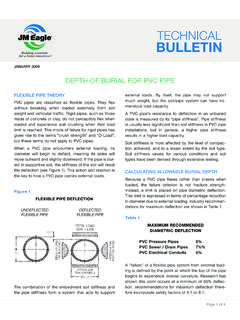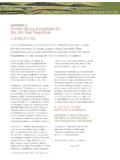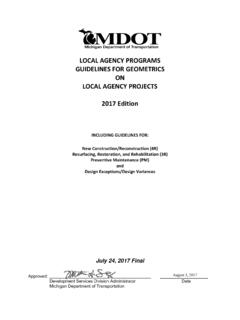Transcription of HCM –Sixth Edition - trafficconf.com
1 Dr. Roger RoessInst it ut e f or Transport at ionResearch and Educat iontrongonceptsHCM sixth Edition Rahim (Ray) BenekohalUniversity of Illinois at Urban Champaign,65thTraffic Engineering and Safety ConferenceOctober 19 20, 2016 What s New in the HCM sixth EditionPlus MoreAcknowledgementSpecial Thanks to:Transportation Research BoardNational Cooperative highway Research ProgramProject No. 03 115 Production of a Major Update to the 2010 highway capacity Manual For Assistance in Preparation of This PresentationThe first 25 slides are selected by Bob Bryson 2 HCM 6thEdition Tentatively Scheduled for Release in Mid 2016 New Title: highway capacity MANUAL6thEditionA Guide for Multimodal Mobility Analysis3 New Research Since HCM 2010 NCFRP 41: truck analysis NCHRP 03 96: managed lanes NCHRP 03 100: roundabouts in corridors NCHRP 03 107: work zone capacity NCHRP 03 115: HCM production NCHRP 07 22: planning guide to HCM SHRP 2 L08: travel time reliability FHWA: ATDM, roundabouts,alternative intersections4 Post 2010 Emerging Topics Chapters After HCM 2010 was published,four emerging topics chapters(35 38) were released online Active Transportation andDemand Management (ATDM)update (Ch.)
2 35) Travel time reliability (Ch. 36, 37) Managed lanes (Ch. 38) Interim chapters and researchcompleted integrated into HCM Allows the use of all methods in combinationMajor New Improvements6 Standardized Volume 2 & 3 Chapter Outline Introduction Concepts Core Motorized Vehicle Methodology Extensions to the Methodology* Mode specific Methodologies* Applications*if provided7 Freeway Facilities Core method described in Chapter 10 New freeway work zone method New managed lanes method New research on truck effects on freeway operations Guidance on evaluating ATDM strategies on typical day freeway operations Improved guidance on segmenting freeways and matching section data from external databases to HCM segments 8 MLGPLcw-minLcw-maxFreeway Reliability Analysis New Chapter 11 Integrates reliabilityanalysis methodology Applies Chapter 10 methodrepeatedly with adjusteddemands, capacities, lanes.
3 And free flow speeds to developa travel time distribution Incorporates demand variation, weather, incident, work zone, and special event effects Produces a variety of useful reliability related performance measures 9 Freeway/Multilane highway Segments Chapter 12 merges the previous individual chapters on basic freeway segments and multilane highways Uses one unified speed flow equation applicable to both freeway and multilane highway segments, but the form of the curves are differentFreewaysMultilane highways10 Unified Speed Flow Equation11 Freeway and Multilane highway Segments Other changes include: Revised truck PCE tables Increased emphasis on calibration through capacity and speed adjustment factors (CAFs and SAFs) Driver population effects now handled by CAFs and SAFs For multilane highways: Density at capacity = 45 pc/mi/ln Revised LOS E F range to reflectrevised density New speed flow curvesfor 65 and 70 mi/h highways12 Freeway and Multilane highway Segments Chapter 26 providesadditional details.
4 Truck performance onextended (long and/orsteep) grades New method for measuringcapacity in the field Updated example problems Users guided to bicycle method in Chapter 15,Two Lane Highways, for evaluating bicycle operations on multilane highways13 Freeway Weaving, Merges and Diverges Chapter 13 and 14 integrate material on managed lane weaving sections and cross weave effects in the general purpose lanes Emphasis on the use of CAFs and SAFs for calibration Chapter 27 and 28 provide new example problems demonstrating the new capabilities14 Urban Street Facilities Service measure changed to average travel speed from average travel speed as percent of free flow speed LOS A/B threshold lowered to the equivalent of80% of free flow speed New method for evaluating spillback Pedestrian and bicycle LOS now weighted by travel time instead of length Example problems moved to Chapter 2915 LOST ravel Speed Threshold by Base Free-Flow Speed (mi/h)
5 Volume-to- capacity Ratioa55504540353025A>44>40>36>32>28>24> 20 >37>34>30>27>23>20>17C>28>25>23>20>18>15 >13D>22>20>18>16>14>12>10E>17>15>14>12>1 1>9>8F 17 15 14 12 11 9 8 FAny > Street Reliability and ATDM New Chapter 17 Integrates material previously appearing in Chapter 35 and interim Chapters 36 and 37 Reliability calculationprocess similar to thatused for freewayreliability analysis Repetitive applicationof Chapter 16 core methodwith varying inputs New guidance on analyzing ATDM strategies16 Urban Street Segments Same service measure changes as described for urban street facilities New method for evaluating segments with midsegment lane blockage Improved procedure for predicting segment queue spillback time New adjustment factor for parking activity that affects free flow speed estimation17N 1 2 3 Work zoneUrban Street Segments Procedure can now evaluate segments with roundabouts at one or both ends Right turn on redvehicles incorporatedinto volume balancingmethod for flows intoand out of a segment Pedestrian and bicycle LOS scores now use time based weighting Changes to bicycle and bus default values18 Signalized Intersections Delay of unsignalized movements can now be considered (user supplied input)
6 Combined saturation flow adjustment factor for heavy vehicles and grade New saturation flow adjustment factors for intersection work zone presence, midsegment lane blockage, and downstream spillback19 Work area lengthEntry taper lengthWidth of each laneSpeed limitDr iv ew a yMedian widthBay lengthSubject direction of travelNDr iv ew aySignalized Intersections Chapter 31 provides animproved planning methodwith reduced input datarequirements andsimplified calculations Example problemsmoved to Chapter 3120Ge ne r al Infor mat ionSit e Infor mat ionAnalystIntersectionAgency or CompanyDate PerformedJurisdictionAnalysis Time PeriodAnalysis YearIntersection Geometry=Through=Right=Left= Through + Right=Left + Through=Left + Right= Left + Through + RightVolume and Signal InputLTLTTHRTLTTHRTLTTHRTR equired DataVolume (veh/h)Number of lanesLane use (exclusive or shared)Optional Data1 Heavy vehicles (%)On-street parking presence (no, yes)Pedestrian activity (none, low, med.)
7 , high, extreme)Left-turn operation and phase sequence2 Effective green time (s)3,4 Progression quality (good, random, poor)4 Peak hour factorCycle length (s) Base saturation flow rate (pc/h/ln)No t e s1. Optional input data (guidance is provided for estimating these data if they are not known).3. Data required for Part I analysis if "protected-permitted operation with left-turn phase" is Data required for Part II Combinations addressed: (a) protected operation with left-turn phase, (b) permitted operation no left-turn ..phase, (c) protected operation split phasing, (d) protected-permitted operation with left-turn phaseStreetStreetShow NorthPLANNING-LEVEL ANALYSIS: INPUT WORKSHEETSBNBWBEBRTTHRamp Terminals and Alternative Intersections The former Interchange Ramp Terminals chapter has been expanded to include a greater variety of distributed intersections Two or more intersections with close spacing and displaced or distributed traffic movements that are operationally inter dependent and are bestanalyzed as a single unit21 Ramp Terminal Forms Addressed22 Intersection Forms Addressed23 Displaced Left TurnRestricted Crossing U-TurnMedian U-TurnRamp Terminals and Alternative Intersections New service measure.
8 Experienced travel time Sum of control delays at each node and extra distance travel time experienced by rerouted movements New and updated example problems are located in supplemental Chapter 3424 Briefing Series Overview What s New HCM 6thEdition New Features in Freeway Analysis Chapter Freeway Reliability and Strategy Assessment Urban Streets Segment Chapter Urban Streets Facility Chapter Signalized Intersection Chapter Signalized Intersection Planning Method Roundabouts Ramp Terminals and Alternative Intersections Planning and Preliminary Engineering Applications Guide to the HCM2526 PLUS MORES lides added by Ray Benekohal27 HCM 2016, has 37 chapters1. Vol 1-Concept; Vol 2, Uninterruptted Flow; Vol 3 Interrupted flow; loose leaf printed2. Vol 4, Application Guide, not printed, electronicFor Basic Freeway Segments Handles managed lanes (HOV, HOT, Express Toll) Speed adj.
9 Factor (SAF), due to weather ( ) capacity adj. factor (CAF):due to weather ( ) due to incident (. ) Driver popu. factor is applied to CAF and SAF Free Flow speed NOT rounded to nearest 5. New procedure for trucks Two terrains: level (PCE= ) and rolling (PCE= ) 28 Weaving SegmentsManaged lane procedureSAF and CAFM erge and Diverge SegmentsManaged lane access SAF and CAFD ensity=flow /speed, finds weighted average speed Freeway FacilitiesManaged lanes, Travel Time Reliability, ATDM, capacity CalibrationWork zones ( , in pcphpl)Find Queue Discharge Rate (QDRwz) Then, compute capacity as: Estimate the WZ by Estimating QDRM3-6average . %How to Estimate = Barrier type = Area type = Lateral distancefrom the edge of travel lane adjacent to the work zone to the barrier, barricades, or cones (0 12 ft) Concrete and hard barrier separation1 Cone,plastic drum,or other soft barrier separation Urban areas High development densities or concentrations of population 1 Rural areas widely scattered development and low housing and employment densities = Daylight/night Daylight1 Night Lane closure severity index (next slide)
10 M3-7 = Concrete and hard barrier separation = 1 Rural area = 2ft = Daylight 2 lanes total, 1 lane closed = pcphplHow to Estimate M3-9WZ at Intersections Estimate WZ presence Adjustment Factor and apply it to Sat flow Adj factors for trucks and grade are combined now (13 adjfactors)Adjustment factor for WZ presence at the intersectionM3-23 11 12 11 Adj. factor for approach width Adj. factor for reducing lanes during WZ presence Approach lane width during WZ (ft) Number of left turn and through lanes open during normal operation (lanes) Number of left turn and through lanes open during WZ presence (lanes)Note: one value is computed for (and is applicable to) all lane groups on the subject intersection approachAdjustment factor for WZ presence at the intersection ( M3-2634 Roundabouts2010, one-lane entry one-lane circulating 2016, one-lane entry one-lane circulating 2016, one-lane entry two-lanes circulating 35201620002010)






